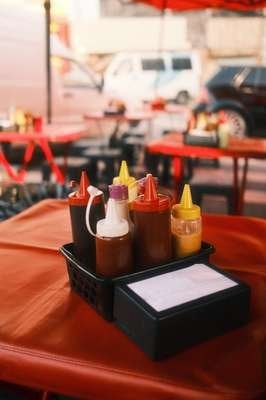Stop ruining your condiments! Experts reveal the best place to store every sauce
By
Danielle F.
- Replies 4
Are you guilty of shoving every bottle, jar, and squeezy tube into the fridge the moment you get home from the shops? Or perhaps you’re a staunch 'cupboard only' type, convinced that all those preservatives mean your sauces are safe at room temperature? Well, it turns out most of us have been storing our condiments all wrong—and the experts have finally settled the great sauce storage debate, including the age-old question: does ketchup really belong in the fridge?
Here at the Seniors Discount Club, we know a good sauce can make or break a meal—whether it’s a dollop of mayo on your fish and chips, a drizzle of maple syrup on your pancakes, or a generous squirt of tomato sauce on, well, just about anything. But where you keep these flavour-boosters can actually affect their taste, texture, and even your health. So, let’s dive into the definitive guide to storing your favourite condiments, with a few extra tips and Aussie context thrown in for good measure!
The Fridge Brigade: Sauces That Need Chilling
Mayonnaise
Despite its tangy vinegar content, mayo is a fridge-dweller. The eggs in mayonnaise make it a breeding ground for nasties if left out, even though it’s pasteurised. So, after opening, pop it in the fridge and keep it tightly sealed.
Pesto
Love a bit of basil pesto on your pasta? Make sure it goes straight into the fridge after opening. Pesto contains nuts, which can develop moulds that are hard to spot (especially in green sauces). Some of these moulds can produce toxins that are harmful to your liver, so don’t take any chances.
Salad Cream
A classic for sandwiches and salads, salad cream also contains eggs. Even though it’s loaded with preservatives, it’s safest in the fridge. If you’re hosting a BBQ, decant what you need into a bowl and return the bottle to the fridge—don’t leave it out in the sun!

Maple Syrup
This one surprises a lot of people. Unlike honey, maple syrup doesn’t have enough sugar to keep mould at bay at room temperature. Once opened, it should be refrigerated to prevent spoilage. Don’t confuse it with golden syrup—they’re not the same!
Tartare Sauce
Another egg-based condiment, tartare sauce should be kept cold. And if you only use it occasionally (hello, fish and chips night!), check the jar before each use.
Redcurrant Jelly
This sweet, tangy jelly can separate, creating a watery layer that’s perfect for mould. Keep it in the fridge, especially after opening.
The Cupboard Crew: Sauces That Are Happy at Room Temp
Ketchup (Tomato Sauce)
Here’s the big one! Despite what you might have heard, tomato sauce doesn’t need to be refrigerated. The vinegar and tomatoes are acidic enough to keep it safe in the cupboard. Of course, if you prefer it cold, that’s fine too—but it’s not a food safety issue.
Brown Sauce
Similar to ketchup, brown sauce is loaded with vinegar and other preservatives. It’s perfectly happy in the pantry.
Honey
Unlike maple syrup, honey is a natural preservative thanks to its high sugar content and a bit of hydrogen peroxide. It’s best kept in the cupboard, just like the bees do.
Mint Sauce
With its high vinegar content, mint sauce is safe in the cupboard. But if you only use it once in a blue moon, the fridge might be a better bet to keep it fresh.
Pickles and Chutneys
These were invented to preserve fruit and veg, so they’re fine at room temperature. Just use a clean spoon or knife to avoid contamination.
Olive Oil
Never put olive oil in the fridge—it’ll go cloudy and solidify. Keep it in a cool, dark cupboard.
Soy Sauce
Despite what the label might say, soy sauce’s high salt content means it’s shelf-stable. The fridge won’t hurt it, but it’s not necessary.
Mango Chutney
Like other chutneys, mango chutney is preserved with sugar and vinegar. Store it in the cupboard.
Malt Vinegar
This one lasts forever, thanks to its high acidity. No need for fridge space here!
Hot Pepper Sauce
Most hot sauces are vinegar-based, so they’re fine in the pantry. Some brands recommend refrigeration, but it’s more about taste than safety.
Worcestershire Sauce
Despite containing fish, Worcestershire sauce is fermented and shelf-stable. It might oxidise over time, but it won’t go off quickly.
Mustard (English, Dijon, Wholegrain)
Mustard is safe in the cupboard, though the colour may fade in warmer weather. If you like it looking bright, the fridge is fine too.
Piccalilli
Packed with vinegar and preservatives, piccalilli is safe at room temperature. If you want it extra crunchy, try the fridge.
A Few Extra Tips for Aussie Pantries

We’d love to hear your thoughts and any family traditions or storage hacks you swear by. Share your stories in the comments below—let’s settle the sauce debate once and for all!
Here at the Seniors Discount Club, we know a good sauce can make or break a meal—whether it’s a dollop of mayo on your fish and chips, a drizzle of maple syrup on your pancakes, or a generous squirt of tomato sauce on, well, just about anything. But where you keep these flavour-boosters can actually affect their taste, texture, and even your health. So, let’s dive into the definitive guide to storing your favourite condiments, with a few extra tips and Aussie context thrown in for good measure!
The Fridge Brigade: Sauces That Need Chilling
Mayonnaise
Despite its tangy vinegar content, mayo is a fridge-dweller. The eggs in mayonnaise make it a breeding ground for nasties if left out, even though it’s pasteurised. So, after opening, pop it in the fridge and keep it tightly sealed.
Pesto
Love a bit of basil pesto on your pasta? Make sure it goes straight into the fridge after opening. Pesto contains nuts, which can develop moulds that are hard to spot (especially in green sauces). Some of these moulds can produce toxins that are harmful to your liver, so don’t take any chances.
Salad Cream
A classic for sandwiches and salads, salad cream also contains eggs. Even though it’s loaded with preservatives, it’s safest in the fridge. If you’re hosting a BBQ, decant what you need into a bowl and return the bottle to the fridge—don’t leave it out in the sun!

Condiments and sauces should be stored depending on their ingredients and shelf life. Image Credit: Pexels/Gustavo Denuncio
Maple Syrup
This one surprises a lot of people. Unlike honey, maple syrup doesn’t have enough sugar to keep mould at bay at room temperature. Once opened, it should be refrigerated to prevent spoilage. Don’t confuse it with golden syrup—they’re not the same!
Tartare Sauce
Another egg-based condiment, tartare sauce should be kept cold. And if you only use it occasionally (hello, fish and chips night!), check the jar before each use.
Redcurrant Jelly
This sweet, tangy jelly can separate, creating a watery layer that’s perfect for mould. Keep it in the fridge, especially after opening.
The Cupboard Crew: Sauces That Are Happy at Room Temp
Ketchup (Tomato Sauce)
Here’s the big one! Despite what you might have heard, tomato sauce doesn’t need to be refrigerated. The vinegar and tomatoes are acidic enough to keep it safe in the cupboard. Of course, if you prefer it cold, that’s fine too—but it’s not a food safety issue.
Brown Sauce
Similar to ketchup, brown sauce is loaded with vinegar and other preservatives. It’s perfectly happy in the pantry.
Honey
Unlike maple syrup, honey is a natural preservative thanks to its high sugar content and a bit of hydrogen peroxide. It’s best kept in the cupboard, just like the bees do.
Mint Sauce
With its high vinegar content, mint sauce is safe in the cupboard. But if you only use it once in a blue moon, the fridge might be a better bet to keep it fresh.
Pickles and Chutneys
These were invented to preserve fruit and veg, so they’re fine at room temperature. Just use a clean spoon or knife to avoid contamination.
Olive Oil
Never put olive oil in the fridge—it’ll go cloudy and solidify. Keep it in a cool, dark cupboard.
Soy Sauce
Despite what the label might say, soy sauce’s high salt content means it’s shelf-stable. The fridge won’t hurt it, but it’s not necessary.
Mango Chutney
Like other chutneys, mango chutney is preserved with sugar and vinegar. Store it in the cupboard.
Malt Vinegar
This one lasts forever, thanks to its high acidity. No need for fridge space here!
Hot Pepper Sauce
Most hot sauces are vinegar-based, so they’re fine in the pantry. Some brands recommend refrigeration, but it’s more about taste than safety.
Worcestershire Sauce
Despite containing fish, Worcestershire sauce is fermented and shelf-stable. It might oxidise over time, but it won’t go off quickly.
Mustard (English, Dijon, Wholegrain)
Mustard is safe in the cupboard, though the colour may fade in warmer weather. If you like it looking bright, the fridge is fine too.
Piccalilli
Packed with vinegar and preservatives, piccalilli is safe at room temperature. If you want it extra crunchy, try the fridge.
A Few Extra Tips for Aussie Pantries
- Check the label: Some sauces have specific storage instructions, especially after opening. When in doubt, follow the manufacturer’s advice.
- Watch the weather: In the height of an Aussie summer, even cupboard-safe sauces can suffer if your kitchen gets too hot. If you’re worried, the fridge is always a safe bet.
- Use clean utensils: Double-dipping or using dirty knives can introduce bacteria, shortening the life of your condiments.
- When in doubt, throw it out: If a sauce looks, smells, or tastes off, don’t risk it—bin it!
Key Takeaways
- Experts have settled the debate on condiments, revealing that mayonnaise, pesto, salad cream, maple syrup, tartare sauce, and redcurrant jelly should all be refrigerated due to their ingredients and risk of spoilage.
- Ketchup, brown sauce, honey, mint sauce, pickles, olive oil, soy sauce, mango chutney, malt vinegar, hot pepper sauce, Worcestershire sauce, mustard (English, Dijon, Wholegrain), and piccalilli are all safe to store in the cupboard, largely thanks to their high levels of acidity, sugar, salt, or preservatives.
- Storing certain sauces incorrectly can pose a health risk, as leaving products like mayonnaise or salad cream out of the fridge can lead to bacterial growth, while maple syrup can quickly develop mould if not kept cold.
- Some condiments, such as mustard and piccalilli, can technically be kept either in the fridge or cupboard, with refrigeration mainly helping with texture and colour rather than food safety, so storage comes down to personal preference.







